Contribute to Our Research |
By Michael - January 4th, 2011 
Fantastic news today to kick off the new year, as Fantagraphics co-publisher Gary Groth revealed in an interview that the company has obtained the rights to re-print the legendary works of artist Carl Barks, finally allowing fans stateside to acquire a definitive collection of his Donald Duck stories. The first volume in the series will be released this fall, with subsequent collections arriving twice a year.
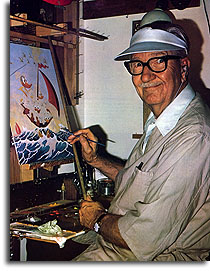 Barks (1901-2000) entertained a generation of comic readers, despite the fact that his work at the time remained anonymous. After a rather remarkable early life that included stints as a farmer, lumberjack, cowboy and even editor of a girlie magazine, Barks came to Disney as an animation inbetweener in 1935. He eventually became a gag man, and picked up some work on the side illustrating a Donald Duck story for Dell comics before quitting the studio to become a chicken farmer. Barks (1901-2000) entertained a generation of comic readers, despite the fact that his work at the time remained anonymous. After a rather remarkable early life that included stints as a farmer, lumberjack, cowboy and even editor of a girlie magazine, Barks came to Disney as an animation inbetweener in 1935. He eventually became a gag man, and picked up some work on the side illustrating a Donald Duck story for Dell comics before quitting the studio to become a chicken farmer.
He soon began crafting new Duck stories for Western Publishing, and over the years until his pseudo-retirement in 1966 he created a rich and elaborate mythos that earned him a reputation among fans as “the good Duck artist.” In that time he created characters like Scrooge McDuck, the Beagle Boys, Gyro Gearloose, Gladstone Gander, Flintheart Glomgold, Magica De Spell, and the entire universe we now think of as Duckburg. After fans began to suss out his identity in the 1960s, he began to reap the praise he had so long deserved. His tales influenced generations of storytellers, including fans George Lucas and Steven Spielberg, and they found new fans through later reprints and their subsequent adaptations in the DuckTales television show of the 1980s.
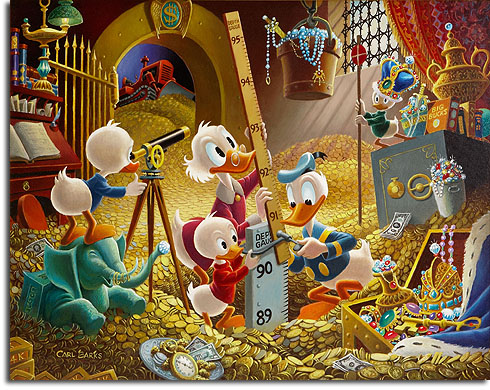
The new Fantagraphics compilation will eventually present the Barks works chronologically, although the first volume to emerge this fall will cover the beginning of his “golden period” with Lost in the Andes from 1948. The second volume, to be released in Spring of 2012 and entitled Only a Poor Old Man, will span the introduction of Scrooge McDuck from 1952-54. Subsequent volumes will fill in the timeline of Barks’s career, and it is estimated that the final release will comprise thirty 240-page volumes. Each hardcover volume will feature around 200 pages of comics along with a wealth of supplemental material, and will retail for around $24.99. Aside from the rather unfortunate decision to present the art at only 90% of its original size, it’s a good deal.
Check out the original interview for more information about the releases and the importance of Barks in the pantheon of 20th century comic art, and for a hint of why it takes so long for us to get nice things when it comes to Disney.
Fair warning: be prepared for me to flog the heck out of these books when they start arriving this fall. I’ve been an obsessed fan of the Duck books since I was a wee bairn, and I’m often shocked just how many die-hard Disney fans are completely oblivious to this treasure trove of impeccable storytelling. Thankfully Barks is finally getting the respect he deserves in America (overseas, the Duck books continue to be a phenomenon), and I look forward to seeing people catch on.
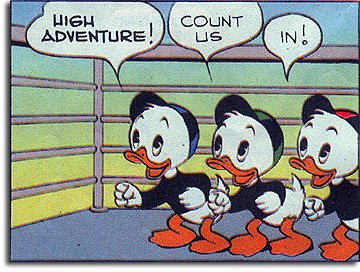
Related Posts...
By Michael - December 25th, 2010 
It’s the holiday season here at Progress City and, as is tradition, the entire metropolis is decked to the nines. The high-rise hotel, towering over downtown, has changed to its shifting red and green lighting scheme; the intra-city WEDway line is festooned with garland and bunting; the public greenbelt is full of colorful inter-faith seasonal displays; and the enclosed central shopping district is bustling, interrupted only by the occasional indoor snow flurry.
As a treat for everyone, what better than a trip to Disneyland, courtesy of Family Circle magazine in December 1958? This magical tour of the kingdom, courtesy of none other than Mr. Toad, is billed as “A Christmas Adventure in Disneyland” by Walt Disney “and his staff.” It’s an interesting peek at how that park, then only three years old, chose to represent itself to families nationwide. Visit Main Street – just as it was in grandma’s day! How odd to think that when this article was written, the jitneys and carolers of Main Street were just as far back as ’57 Chevys and Elvis are today. In fact, the Disneyland of opening day is just as far removed from modern guests as the genteel Victorian gingerbread of Main Street was to visitors in 1955.
So saddle up with Toady and let’s head for the park, and if we’re lucky maybe next year we’ll have a rocket-powered Christmas tree of the future ourselves!
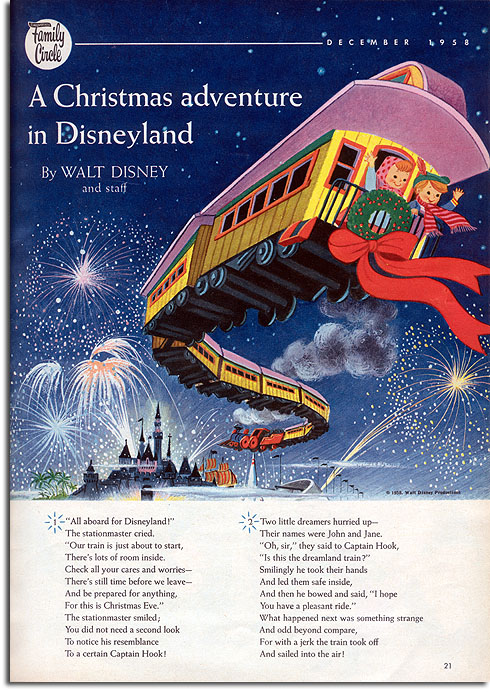


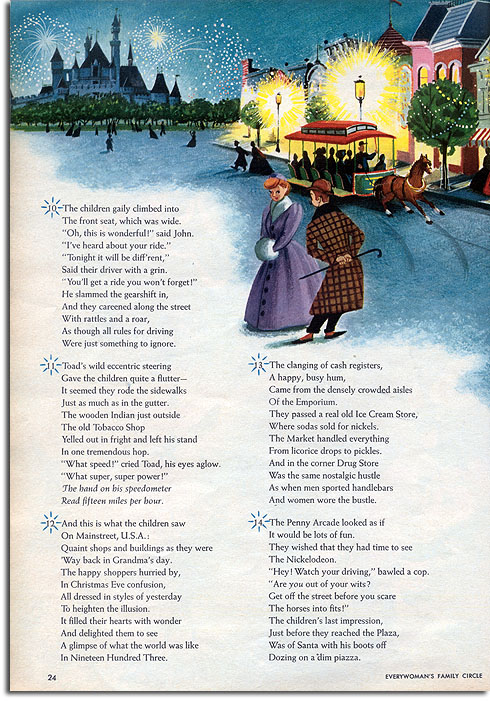
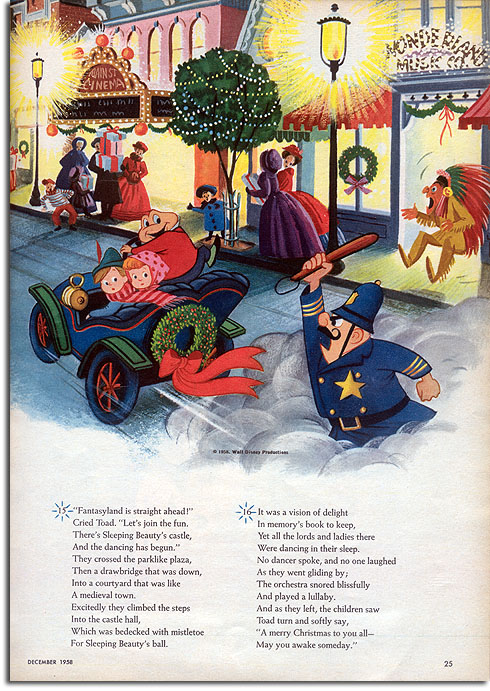
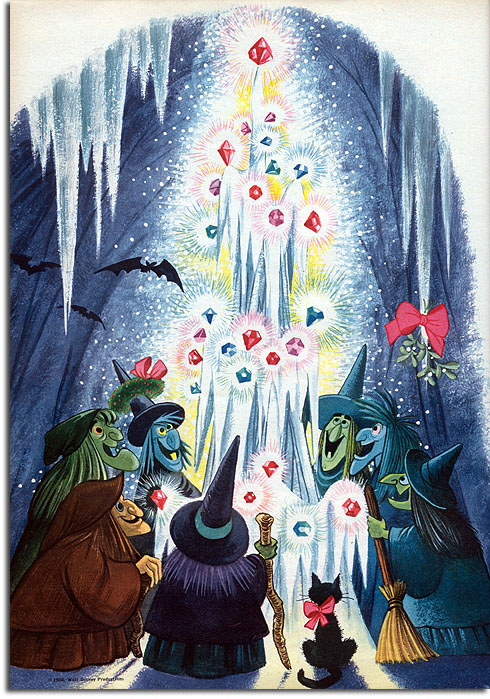
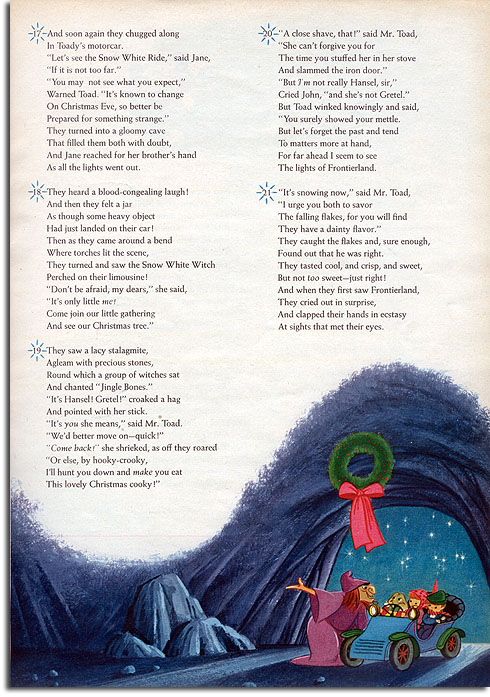

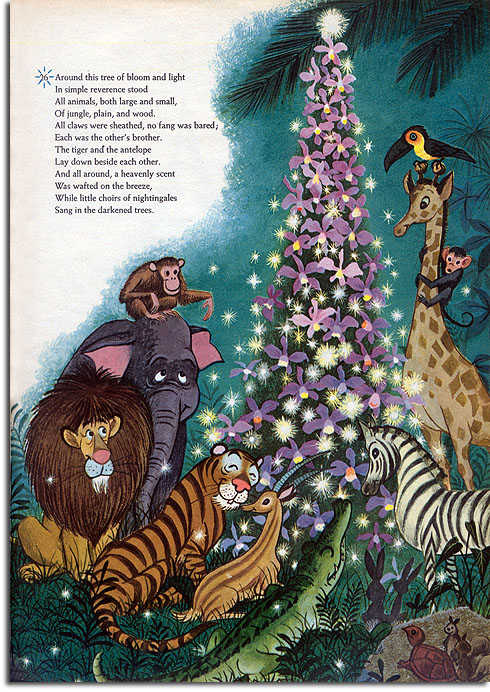
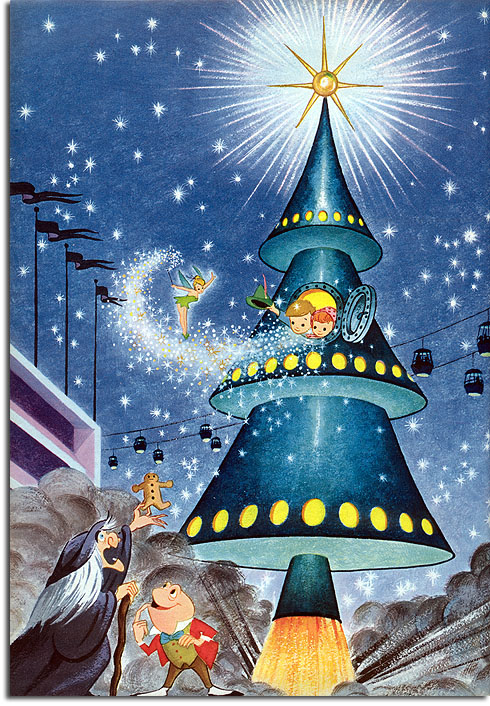
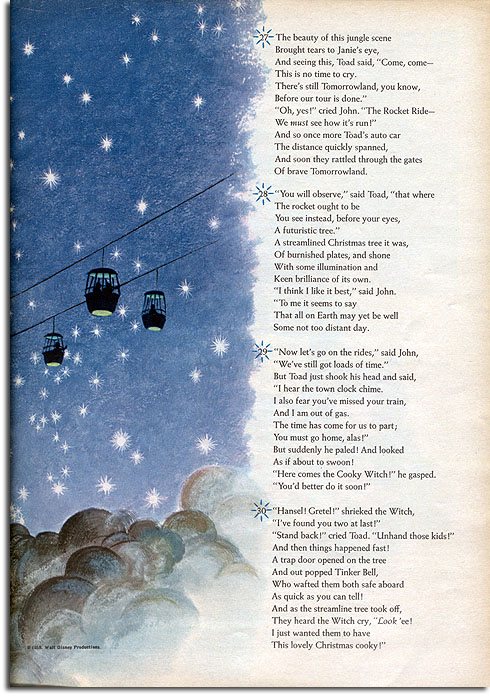
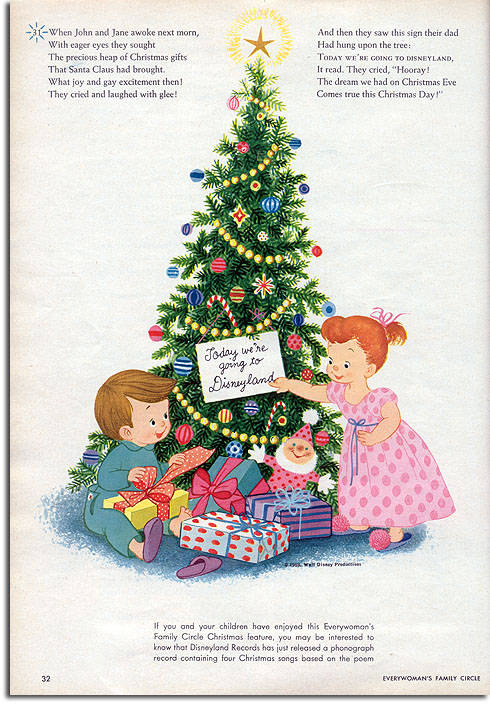
Related Posts...
By Michael - December 24th, 2010 In the ninth volume of the Walt’s People series, edited by Didier Ghez, there’s an interview conducted by John Culhane with Disney artist Art Scott. Scott relates a story from the 1970s, when he approached Disney’s then-CEO Card Walker about Once Upon A Wintertime. Scott had worked on the short, which was part of the 1948 package feature Melody Time, and felt that its title song (performed in the film by Frances Langford) really deserved a spot as a holiday standard. According to Scott, he told Walker that the short should be put into yearly rotation like other Christmas classics.
Well, that obviously never happened but perhaps we can pick up the torch and bring some attention to the song and the short. Here’s Once Upon A Wintertime, with design work by Disney icon Mary Blair. Why not incorporate the song into your next round of wassailing?
Related Posts...
By Michael - December 23rd, 2010 
It’s a pleasant coincidence that just a week after we mentioned former Disney animator Jerry Rees in an article about the original TRON from 1982, we discover via a post on Cartoon Brew that Rees has unveiled his own website and it is most definitely not to be missed.
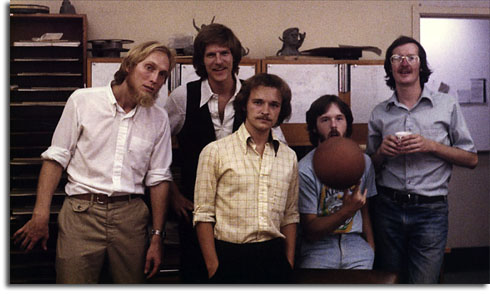 Derisively dubbed the “Rats” by animator Don Bluth, who saw them as a threat, animators Henry Selick ( The Nightmare Before Christmas, Coraline), Bill Kroyer, Jerry Rees, Brad Bird ( The Iron Giant, Ratatouille, The Incredibles), and John Musker ( The Little Mermaid, Aladdin, The Princess and the Frog) would go on to change the animation world The site is an incredible treasure trove of goodies for fans, especially for those interested in that mysterious and fascinating period known as the 1980s, when the art and industry of American animation were undergoing some fundamental changes. Rees worked at the Disney animation studio in those fallow times, and the behind-the-scenes photos on his site are a real who’s-who of young animation talent. There are many familiar faces that would lead Disney into its renaissance period, many who would depart to found Pixar, and others who went in completely different directions. There are scads of fascinating oddities here, and some things I’ve wanted to see for a long, long time – things like Luau, the 1982 short film by Rees and fellow Disney animator Tim Burton:
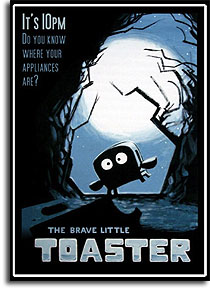 Rees directed the 1987 feature The Brave Little Toaster, an independently produced film that had its origins as a project at the Disney studio. Originally proposed by John Lasseter in the early 1980s as a showcase for computer animation, the project ran up against reluctant corporate management and allegedly led directly to Lasseter’s termination from the studio. Disney production head Tom Wilhite left the studio and set up Hyperion Pictures in 1984, and with him he took the Toaster project. Rees was brought on to direct, storyboarding the adaptation with Joe Ranft, and led a team of Disney expatriates in the creation of what remains one of the most overlooked gems in feature animation history. Rees directed the 1987 feature The Brave Little Toaster, an independently produced film that had its origins as a project at the Disney studio. Originally proposed by John Lasseter in the early 1980s as a showcase for computer animation, the project ran up against reluctant corporate management and allegedly led directly to Lasseter’s termination from the studio. Disney production head Tom Wilhite left the studio and set up Hyperion Pictures in 1984, and with him he took the Toaster project. Rees was brought on to direct, storyboarding the adaptation with Joe Ranft, and led a team of Disney expatriates in the creation of what remains one of the most overlooked gems in feature animation history.
Disney apparently helped back the film and owned the distribution rights, but kept the film from a theatrical release in favor of a debut on the Disney Channel. This is where I first saw it, as a child of the 80s, and not understanding the world of film distribution deals and independent production companies, I didn’t understand how this animated movie I had never heard of just popped up on TV unheralded. Toaster was one of those films that got taped and put into constant rotation in our household, where it was practically memorized verbatim. After growing up a little, it was good to revisit the film and find out that not only does it hold up, but it’s better than I remember – mostly because now I realize how much it stands apart from so many inferior films and how many risks it takes. While its animation suffers from the necessities of its low-budget roots, story-wise it really is one of those rare animated films that holds up with Disney’s best. I hope to revisit it here in some detail in the future.
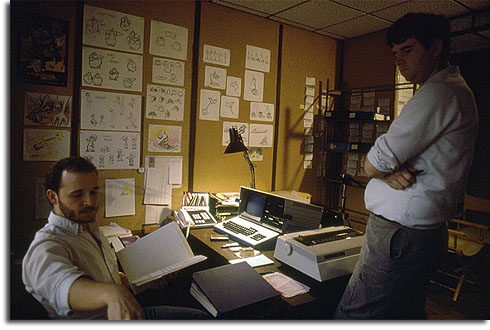 Jerry Rees and Joe Ranft, hard at work on The Brave Little Toaster But back to Rees – he’s worked on a number of projects that are near and dear, including several films for theme park projects. These include the still-beloved Back to Neverland with Walter Cronkite and Robin Williams, Cranium Command, and Cinemagique. His site bills a secret new project for Disney that will debut in 2013. 2013? Hmm…
It’s all there on his site, with lots of behind-the-scenes photos, including information about a proposed predecessor to CAPS that Lucasfilm rejected, Brad Bird’s lost and lamented adaptation of The Spirit, and something you definitely didn’t expect to see today – a volleyball game pitting Tim Burton against Moochie. Now that’s what I call a Christmas miracle.
Related Posts...
By Michael - December 23rd, 2010 And by awesome, I mean posting this picture:
 A very groovy Jimmie Rodgers holding court in the Top of the World Lounge at the Contemporary Resort The Disney Parks blog has announced a new cookbook for Walt Disney World, and in a nifty turn this new book features vintage dishes from the resort as well as current recipes. A post on the official Disney blog with mentions of the Lake Buena Vista Club and Top of the World? Has the world gone mad?
Check out the original post for ordering information, and for a free recipe – Steak Diane from the Lake Buena Vista Club!
Related Posts...
|
The Progress City Primer
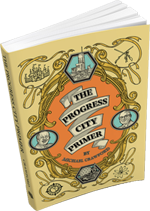 From the Progress City archives comes this collection of 33 tall tales and true from Disney history. Available in paperback, hardback, and ebook formats. |
 Barks (1901-2000) entertained a generation of comic readers, despite the fact that his work at the time remained anonymous. After a rather remarkable early life that included stints as a farmer, lumberjack, cowboy and even editor of a girlie magazine, Barks came to Disney as an animation inbetweener in 1935. He eventually became a gag man, and picked up some work on the side illustrating a Donald Duck story for Dell comics before quitting the studio to become a chicken farmer.
Barks (1901-2000) entertained a generation of comic readers, despite the fact that his work at the time remained anonymous. After a rather remarkable early life that included stints as a farmer, lumberjack, cowboy and even editor of a girlie magazine, Barks came to Disney as an animation inbetweener in 1935. He eventually became a gag man, and picked up some work on the side illustrating a Donald Duck story for Dell comics before quitting the studio to become a chicken farmer.




























Recent Comments